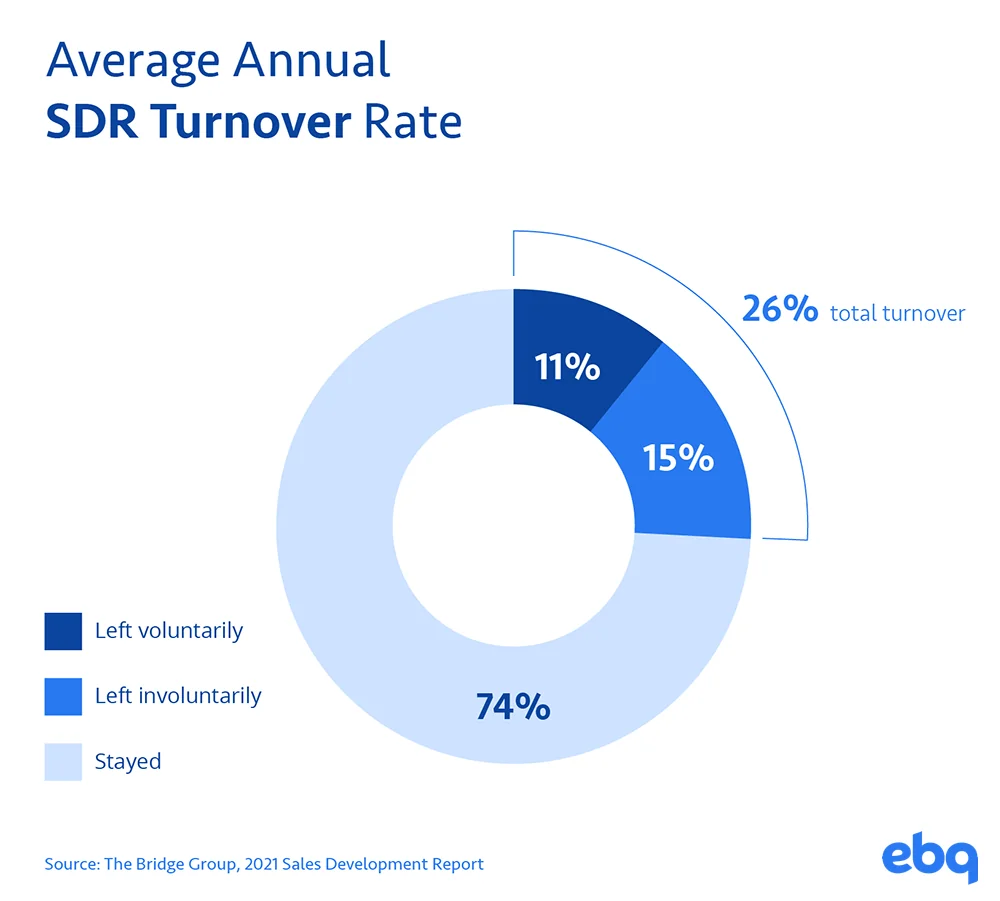Key Strategies to Reduce SDR Team Attrition and Keep Reps Motivated


Dalia Arroyo
Many companies have experienced losing an SDR or two much sooner than they anticipated. Your SDR attrition rate is the rate at which sales development reps are leaving your company. Sadly, it’s no secret that the turnover rate for SDRs can be much higher than other roles.
But, why are your SDRs leaving their jobs much quicker than other team members, and what effect does it have on your business?
By reading this post, you will gain valuable strategies that can be implemented to help decrease SDR turnover. Before we dive into those tactics, it’s important to gain a deeper understanding of the causes, effects, and costs of attrition.

Download the SDR Metrics E-Book
Discover which KPIs you should track to help improve your SDRs’ performance.
SDR turnover rate statistics
If you face a high turnover rate, you aren’t alone. According to The Bridge Group, 11% of SDRs voluntarily resigned from their role while 15% of SDRs involuntarily left their position in 2020.
While 74% of SDRs stay in their current role per year on average, losing 26% of your sales development reps per year can take a toll. Ideally, businesses should aim for a 10% turnover rate among their SDRs or any other role.
For the 15% that are involuntarily terminated, tactics like better training and support can improve SDR performance, which compels companies to keep more of their reps on board.
For the 11% of the SDRs that are choosing to resign, what could cause them to leave?

Causes of high SDR turnover
When a company sees their SDRs leave at an alarming rate, it could be happening because of these reasons:
- They are overworked and underpaid
- Your SDRs have little opportunity for growth
- Their duties are repetitive and discouraging
As an entry level role, SDR turnover is inevitable. If an employee is good at being an SDR, they can be good at many things.
You should expect that and plan for it, because turnover can end up costing you a ton of money. One effective way to solve this is outsourcing the SDR role. An experienced sales development firm like EBQ helps you minimize the impact of turnover— acting as an HR bypass to quickly hire and ramp new SDRs.
However, if you’re determined to solve turnover on your own, many of the reasons mentioned above can be addressed by your business. Later in the post, we’ll discuss SDR retention best practices based on our own experience of building our team of top sales development talent.
Before we dive into SDR attrition reduction strategies, you first need to understand the effects of a high turnover rate.
Effects of a higher turnover
When your company experiences a high attrition rate, there is a ripple effect that impacts everyone, including the remaining sales development reps and your prospects.
Lower productivity & morale
A recent study found that sales development reps take about 3 months to fully ramp up while another study shared that the average tenure for an SDR is about 1.8 years.
This means that you’re only getting about a year and a half of full productivity before your SDRs pack up.
Along with low productivity, this quick turnaround also negatively impacts morale. As sales development reps come and go, the other SDRs may feel discouraged and decide to leave earlier than expected as well. This could happen because they lost meaningful connections with coworkers or they were given more tasks that were left behind by the departed SDRs.
Increased hiring & onboarding costs
The truth is that the higher your turnover rate is, the higher your hiring costs will be. Costs can pile up if your business is continually hiring and onboarding new sales development reps.
One study shows that hiring an in-house SDR team costs up to $10,000 per SDR per month — and that doesn’t account for the cost of tools and software they need to be productive and effective.
This total comes from a variety of factors:
- Hard costs like benefits, employment taxes, and equipment
- Recruiting expenses including the laborious interview process
- The extra time spent to train the new SDRs
These costs are part of the reason many companies turn to an external SDR company to alleviate the pressure and costs of constantly hiring and onboarding. Keep in mind that not all outsourced firms are created equally. We’ve written previously about the factors to consider when selecting the right SDR firm.
Lost sales opportunities
High SDR turnover not only affects your other team members. It can impact the prospect experience and your pipeline as well.
There are a few ways you may lose out on opportunities because of turnover:
- Inexperienced SDRs: If you’re constantly hiring new reps for the role, the less experienced reps won't be as skilled in qualifying leads and closing on sales meetings.
- Neglected leads: With many SDRs leaving your company, there’s a higher chance some prospects will fall through the cracks by never being reassigned or followed up with down the line.
- Bad first impressions: As leads get reassigned when SDRs depart, a new rep now needs to form a connection with them. Your brand reputation is at risk if the new rep isn’t up to speed on past conversations and discovery info that has already been uncovered.
As you can see, a high turnover rate greatly impacts your business across all aspects. So, what can you do to minimize SDR turnover?
Strategies to minimize SDR team attrition
Don’t become desensitized to a high SDR turnover rate. There are multiple strategies you can implement to increase SDR retention instead of stressing over the costs of high attrition.
Proper onboarding & training
One of the most significant turnover effects we’ve covered is the costs and time it takes to continually onboard and train a revolving door of new SDRs.
To avoid this arduous process, provide SDRs with tools that will help them succeed right away. This will boost their confidence and help them see the fruits of their labor sooner.
To ensure your SDRs have a successful start, carry out these practices:
- Have a playbook: This playbook should explain the processes that your SDRs should follow. If you aren’t sure how to create one, our post — How to Create Your Own SDR Playbook — can help.
- Set clear expectations: Ensure your sales development reps know what is expected of them. Set clear expectations by outlining achievements, milestones, and quotas that should be accomplished within a certain timeframe.
- Ensure your managers are accessible: Your SDRs are bound to have questions, so make sure your managers are easily accessible to address inquiries. This allows for any uncertainties to be cleared up quickly and helps your sales development reps feel supported.
Opportunities for career development
One way to encourage your SDRs to stay onboard is by providing opportunities for career advancement.
As mentioned earlier, the duties of an SDR can be repetitive and discouraging. But this entry-level role can also be a stepping stone towards your reps’ ideal career, so offer guidance as they progress in their role.
At EBQ, we provide training programs that allow for vertical or horizontal career moves. For example, our SDRs can attend trainings that teach them how to become a team lead or manager — as well as trainings to move into another discipline, such as marketing.
While a promotion or a move to another department may eventually leave you one SDR short, this possibility of career growth can motivate SDRs to perform their best while sticking with your team. Additionally, these role vacancies are typically easier to plan for versus sudden departures.
Fair compensation & recognition
Another way to better retain SDRs is to revisit your compensation structure for the role. After all, the majority of employees who leave a job cite low pay as their reason.
Many companies set a low base pay for their SDRs and augment total earnings through commission. The issue with revenue-based commission is that revenue is largely dependent on the sales team’s ability to close deals, not on SDR performance.
We learned early on at EBQ that one of the most effective ways to keep SDRs long-term is offering a competitive full-time salary and benefits. It’s helped us maintain a lower turnover rate than competitors and retain our skilled reps.
Though we generally advise against commission, we do suggest setting up a bonus structure to reward high-performing SDRs as well.
While money is a large contributor to retaining your SDRs, you can also lower your SDR attrition rate by recognizing their accomplishments. Your SDRs will feel much more appreciated when they are surrounded by camaraderie celebrating their hard work.
Be prepared to handle inevitable turnover
Remember that even after applying these strategies, you will still face some SDR turnover. Since it can’t be avoided entirely, it’s important to ensure you have a smooth hiring process to find the best SDRs for your company.
When turnover hits, there are a few steps you can utilize to hire the right SDRs:
- Attract applicants with an accurate job description and clear expectations
- Screen candidates and ask strategic questions during the in-person interview
- Continuously recruit and interview new talent that can fill vacant roles
By implementing a seamless hiring process, you’ll have a qualified pool of candidates on the sideline ready to join your team.
As mentioned earlier, many companies choose to outsource the SDR role to mitigate this inevitable turnover all together. When you work with an outsourced SDR firm like EBQ, you can get a fully-trained SDR team while we handle turnover, hiring, and training. And with our experience retaining SDRs, some of our clients even get to work with the same reps for years.

Download the SDR Metrics E-Book
Discover which KPIs you should track to help improve your SDRs’ performance.
Reduce SDR turnover with proper support
Your high SDR attrition rate doesn’t need to last forever. There are tactics you can follow to ensure your SDRs don’t feel underpaid and discouraged.
By offering proper training, career advancement, and competitive compensation, you can lower your SDR turnover rate.
If you’re looking for an alternative method to boost your pipeline without the hassle of turnover, our knowledgeable SDRs can act as an extension of your company at a fraction of the cost. Visit our sales development services page to learn more.
